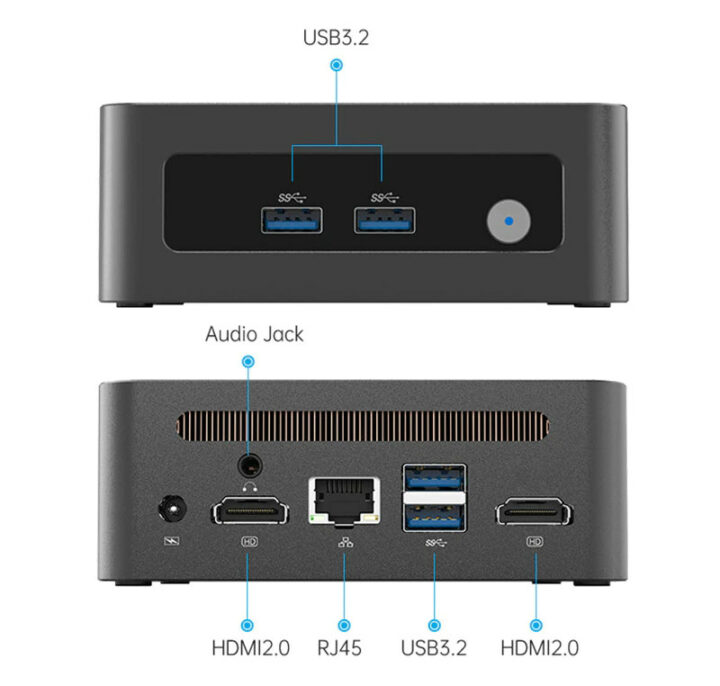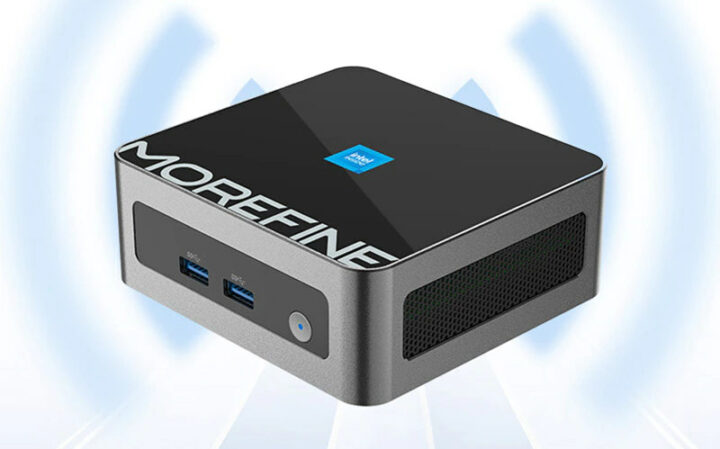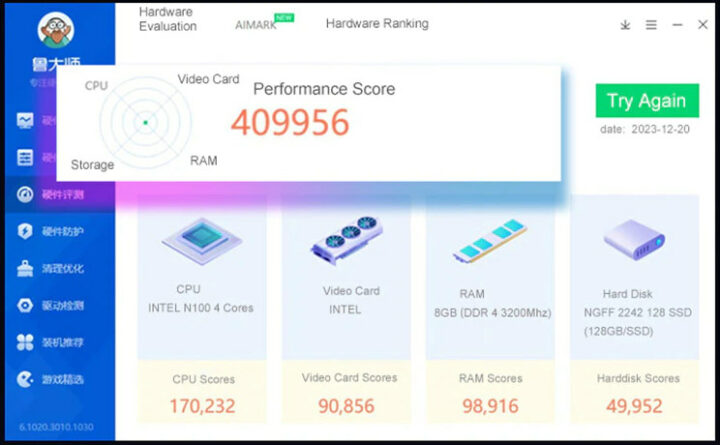Morefine M9 is one of the first mini PCs I’ve seen sold with the 6W Intel Processor N100 Alder Lake-N quad-core processor and the price is not too bad with $199 asked for a barebone model on Aliexpress.
The mini PC supports up to 32GB DDR4 RAM, is sold up with up to 1TB NVMe SSD, and features two 4K-capable HDMI 2.0 ports, 2.5 Gbps Gigabit Ethernet, a WiFi 6 & Bluetooth 5.2 module, as well as four USB 3.2 ports.
Morefine M9 specifications:
- SoC – Intel Processor N100 quad-core Alder Lake-N processor @ up to 3.4 GHz (Turbo) with 6MB cache, 24EU Intel HD graphics; TDP: 6W
- System Memory – Up to 32GB DDR4-3200MHz
- Storage
- M.2 2280 PCIe/NVMe socket fitted 128GB, 256GB, 512GB, or 1TB SSD
- M.2 2242 SATA socket
- Video Output – 2x HDMI 2.0b ports up to 4Kp60; dual independent display support
- Audio – 1x audio jack
- Networking
- 2.5GbE RJ45 port
- Wi-Fi 6 and Bluetooth 5.2 module
- USB – 4x USB 3.2 ports
- Misc – “Silent fan” and copper heatsink for cooling
- Power Supply – 12V/3A via DC jack
- Dimensions – 113 x 106 x 42mm
- Weight – 240 grams
 Morefine says the mini PC can run Windows 10, Windows 11, Ubuntu, or other Linux distributions, but unless you are getting the barebone model, the company will preinstall Windows 11 on the device.
Morefine says the mini PC can run Windows 10, Windows 11, Ubuntu, or other Linux distributions, but unless you are getting the barebone model, the company will preinstall Windows 11 on the device.
Alder Lake-N processors are supposed to succeed the Jasper Lake family and the Intel Processor N100 mini PC is said to offer 20% faster overall system performance compared to a system with an Intel Celeron N5105 Jasper Lake processor in some unknown (to me) benchmark.
The Morefine M9 is not the very first Intel Processor N100 mini PC we’ve covered since we wrote about the upcoming MSI Cubi N ADL mini PC earlier this month, but the advantage is that the M9 can be purchased now for $199 for the barebone model and up to $403.51 with 32GB RAM and a 1TB NVMe SSD.
Via AndroidPC.es

Jean-Luc started CNX Software in 2010 as a part-time endeavor, before quitting his job as a software engineering manager, and starting to write daily news, and reviews full time later in 2011.
Support CNX Software! Donate via cryptocurrencies, become a Patron on Patreon, or purchase goods on Amazon or Aliexpress







Interesting for sure.
Although I would have hoped that a mini PC with a 6W processor could run without a fan?
The 6W TDP spec applies to the “Base frequency” which according to Geekbench browser is around 798 MHz here. As long as you limit the CPU cores to this and prevent them from ‘bursting’ to the more relevant 3.4 GHz fanless should be OK. 😉
TL;DR: Intel’s TDP numbers are and always were more or less a scam.
OK, now I understand why Intel is not showing the base frequency on Intel Ark. It would be bad marketing!
According to Geekbench browser N200’s Base Frequency is 1.0 GHz (same 6W TDP), N300 back at 800 MHz (7W TDP) and N305 is listed with 1.8 GHz (15W TDP).
So for anyone wondering about the huge 8W TDP difference between N300 and N305: not much physical reasons involved since it’s mostly the funny ‘Base Frequency’ definitions of 800 MHz vs. 1800 MHz. A true marketing genius at work over at Intel 🙂
Without a fan and weighing under 3 pounds is what I want.
Preferably under 2 pounds unless the extra pound really helps with heat dissipation.
Intel says the N100 max memory is only 16GB, but the site and description claim 32GB. Does the manufacturer just imply that you could use 32GB, but not utilize it? https://www.intel.com/content/www/us/en/products/sku/231803/intel-processor-n100-6m-cache-up-to-3-40-ghz/specifications.html
I don’t know why but the information about max memory capacity has never been accurate on the Intel Ark website. Not only for Alder Lake-N, but it’s going back years.
Yeah I remember this for Atoms which were said to be limited to 2GB while in fact it was 2GB per core, so that dual-core ones supported 4GB despite the site saying 2. I think they don’t enforce limits but reserve the right to change that over time so as to just segment their market. But here at $128 they could relax the memory size limits a little bit…
Long time problem with Intel’s low end CPUs probably caused by memory controller limitations (where Intel’s specced max size always works regardless of DIMMs used but larger memory sizes only work with specific DIMMs and often only single-channel).
Here’s some insights with Gemini Lake (take PEBKAC into account but the insight in general applied to everything Gemini Lake [Refresh] and not just this ODROID board). The memory controller with Goldmont [Plus] Intel CPUs often could cope with 4 x Intel’s specced size as long as the modules weren’t too fast.
Network port is 2,5GBit
Thanks for letting me know. I’ve updated the post accordingly.